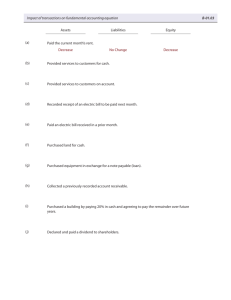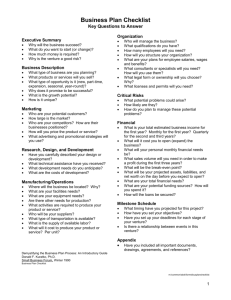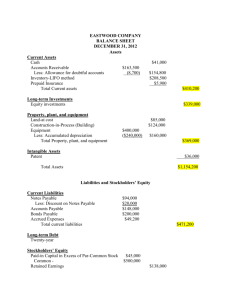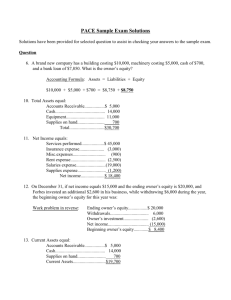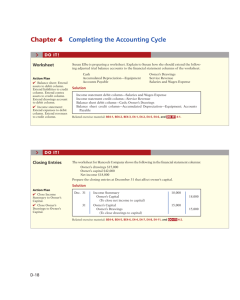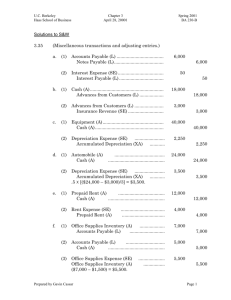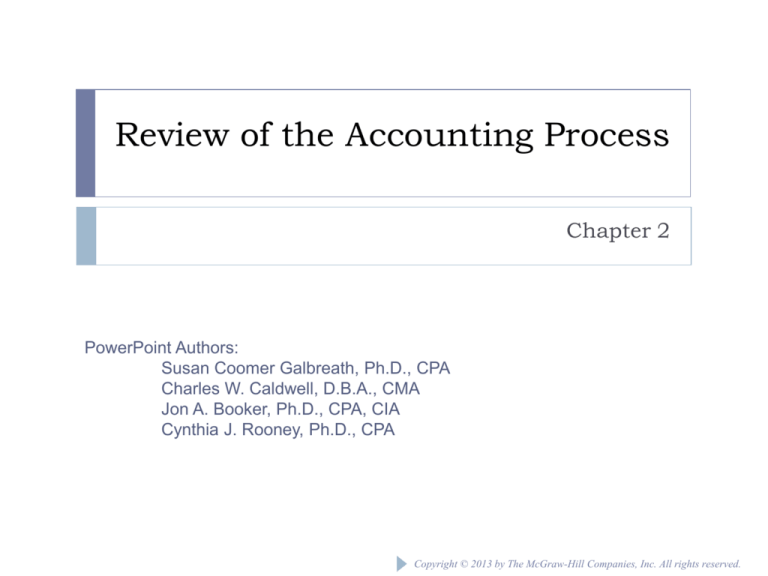
Review of the Accounting Process
Chapter 2
PowerPoint Authors:
Susan Coomer Galbreath, Ph.D., CPA
Charles W. Caldwell, D.B.A., CMA
Jon A. Booker, Ph.D., CPA, CIA
Cynthia J. Rooney, Ph.D., CPA
Copyright © 2013 by The McGraw-Hill Companies, Inc. All rights reserved.
2-2
OVERVIEW
Chapter 1 explained that the primary means of conveying
financial information to investors, creditors, and other
external users is through financial statements and related
notes. The purpose of this chapter is to review the
fundamental accounting process used to produce the
financial statements.
This review establishes a framework for the study of the
concepts covered in intermediate accounting.
Actual accounting systems differ significantly from company
to company.
This chapter focuses on the many features that tend to be
common to any accounting system.
2-3
The Accounting Equation
A = L + OE
+ Owner Investments
- Owner Withdrawals
+ Revenues
+ Gains
- Expenses
- Losses
2-4
Accounting Equation for a Corporation
A = L + SE
+ Paid-in Capital
+ Retained Earnings
+ Revenues - Expenses - Dividends
+ Gains
- Losses
Accounting Equation, Debits and
Credits, Increases and Decreases
Permanent Accounts—assets, liabilities, paid-in capital, retained earnings
Temporary Accounts-revenues, gains, expenses, losses
2-5
10 Steps
Source
Documents
During the Accounting Period
Transaction
Analysis
Record in
Journal
2-6
Post to
Ledger
At the End of the Accounting Period
Financial
Statements
Adjusted
Trial Balance
Record & Post
Adjusting
Entries
At the End
of the Year
Close Temporary
Accounts
Post-Closing
Trial Balance
Unadjusted
Trial Balance
The
Accounting
Processing
Cycle
2-7
The Steps of the Accounting Processing Cycle
Example :
Heidi Jara opened Jara’s Cleaning Service on July 1, 2015.
During July, the following transactions were completed.
July 1- Stockholders invested $20,000 cash in the business
in exchange for common stock.
1- Purchased used truck for $9,000, paying $4,000 cash
and the balance on account.
3- Purchased cleaning supplies for $2,100 on account.
5- Paid $1,800 cash on a 1-year insurance policy effective
July 1.
12- Billed customers $4,500 for cleaning services.
18 - Paid $1,500 cash on amount owed on truck and $1,400
on amount owed on cleaning supplies.
2-8
2-9
20 - Paid $2,500 cash for employee salaries.
21- Collected $3,400 cash from customers billed on July
12.
25- Billed customers $6,000 for cleaning services.
31- Paid $350 for the monthly gasoline bill for the truck.
31- Paid a $5,600 cash dividend.
The chart of accounts for Jara’s Cleaning Service contains
the following accounts: No. 101 Cash, No. 112 Accounts
Receivable, No. 126 Supplies, No. 130 Prepaid Insurance, No.
157 Equipment, No. 158 Accumulated Depreciation—
Equipment, No. 201 Accounts Payable,
2-10
No. 212 Salaries and Wages Payable, No. 311 Common
Stock, No. 320 Retained Earnings,
No. 332 Dividends, No. 350 Income Summary, No. 400
Service Revenue, No. 631 Supplies Expense, No. 633
Gasoline Expense, No. 711 Depreciation Expense, No. 722
Insurance Expense, and No. 726 Salaries and Wages
Expense.
Instructions
(a) Journalize and post the July transactions.
(b) Prepare a trial balance at July 31
(c) Enter the following adjustments
2-11
(1) Unbilled and uncollected revenue for services performed
at July 31 were $2,700.
(2) Depreciation on equipment for the month was $500.
(3) One-twelfth of the insurance expired.
(4) An inventory count shows $600 of cleaning supplies on
hand at July 31.
(5) Accrued but unpaid employee salaries were $1,000.
d) Prepare a adjusted Trial Balance on July 31.
e) Prepare an income statement and a retained
earnings statement for July and a classified balance
sheet at July 31.
(f)Journalize and post closing entries and complete
the closing process.
(g) Prepare a post-closing trial balance at July 31.
2-12
Adjusting Entries
At the end of the period, adjusting entries are
required to satisfy the realization principle and
the matching principle.
Prepayments
Accruals
Estimates
Transactions where
cash is paid or received
before a related
expense or revenue is
recognized.
Transactions where
cash is paid or received
after a related expense
or revenue is
recognized.
Accountants must often
make estimates in order
to comply with the
accrual accounting
model.
2-13
Prepaid Expenses
Expense
Asset
Unadjusted
Balance
Credit
Adjustment
Today, I will pay
for my first
6 months’ rent.
Debit
Adjustment
Prepaid Expenses
Items paid for in advance
of receiving their benefits
2-14
Depreciation
Depreciation is the process of allocating the cost of plant
and equipment over their expected useful lives.
Straight-Line
Depreciation
Asset Cost - Salvage Value
=
Useful Life
2-15
Depreciation
After posting, the accounts look like this:
Furniture and Fixtures
Beg. bal.
12,000
Bal.
12,000
Depreciation Expense
Beg. bal.
200
Bal.
200
Accumulated Depreciation
Beg. bal.
200
200 Bal.
2-16
Unearned Revenues
Liability
Debit
Adjustment
Unadjusted
Balance
Buy your season tickets for
all home basketball games NOW!
“Go Big Red”
Revenue
Credit
Adjustment
Unearned Revenue
Cash received in
advance of performing
services
2-17
Accrued Liabilities
Expense
Debit
Adjustment
I won’t pay you
until the job is done!
Liability
Credit
Adjustment
Accrued Liabilities
Liabilities recorded when an
expense has been incurred
prior to cash payment.
2-18
Accrued Receivables
Asset
Debit
Adjustment
Yes, you can pay me
in May for your April
15 tax return.
Revenue
Credit
Adjustment
Accrued Receivables
Revenue earned in a
period prior to the cash
receipt.
Adjusting Entries
2-19
2-20
Estimates
Accountants often must make estimates of
future events to comply with the accrual
accounting model.
Examples
Depreciation
Uncollectible accounts
$
2-21
The Income Statement
Dress Right Clothing Corporation
Income Statement
For Month Ended July 31, 2013
Sales revenue
$
Cost of goods sold
Gross profit
Other expenses:
Salaries
$
10,500
Supplies
800
Rent
2,000
Depreciation
200
Total operating expenses
Operating income
Other income (expense):
Rent revenue
250
Interest expense
(333)
Net income
$
38,500
22,000
16,500
13,500
3,000
(83)
2,917
The income statement summarizes the results
of profit-generating activities of the company.
The Statement of Comprehensive
Income
A few types of gains and losses, called other
comprehensive income (OCI) or loss items, are
excluded from the determination of net income and
the income statement, but are included in the broader
concept of comprehensive income.
In the single statement approach, net
income is a subtotal within the
statement followed by these OCI
items, culminating in a final total of
comprehensive income.
In the two statement approach, a
company presents an income
statement followed by a statement of
comprehensive income.
We will discuss comprehensive income in more depth in Chapter 4.
2-22
2-23
The Balance Sheet
Dress Right Clothing Corporation
Balance Sheet
At July 31, 2013
Assets
Current assets:
Cash
Accounts receivable
Supplies
Inventory
Prepaid rent
Total current assets
Property and equipment:
Furniture and fixtures
Less: Accumulated depreciation
Total assets
$
$ 12,000
200
68,500
2,000
1,200
38,000
22,000
131,700
11,800
$ 143,500
The balance sheet presents the financial
position of the company on a particular date.
2-24
The Balance Sheet
Dress Right Clothing Corporation
Balance Sheet
At July 31, 2013
Liabilities and Shareholders' Equity
Current liabilities:
Accounts payable
Salaries payable
Unearned rent revenue
Interest payable
Note payable
Total current liabilities
Long-term liabilities:
Note payable
Shareholders' equity:
Capital stock
Retained earnings
Total shareholders' equity
Total liabilities and shareholders' equity
$
35,000
5,500
750
333
10,000
51,583
30,000
$
60,000
1,917
$
61,917
143,500
Notice that assets of $143,500 equals total
liabilities plus shareholders’ equity of $143,500.
2-25
The Statement of Cash Flows
Dress Right Clothing Corporation
Statement of Cash Flows
For the Month of July 2013
Cash flows from Operating Activities:
Cash inflows:
From customers
From rent
Cash outflows:
For rent
For supplies
To suppliers for merchandise
To employees
Net cash used by operating activities
Cash flows from Investing Activities:
Purchase of furniture and fixtures
Cash flows from Financing Activities:
Issue of capital stock
Increase in notes payable
Payment of cash dividend
Net cash provided by financing activities
Net increase in cash
$
36,500
1,000
(24,000)
(2,000)
(25,000)
(5,000)
$ (18,500)
(12,000)
$
60,000
40,000
(1,000)
$
99,000
68,500
The statement of cash flows discloses the
changes in cash during a period.
2-26
The Statement of Shareholders’ Equity
Dress Right Clothing Corporation
Statement of Shareholders' Equity
For the Month of July 2013
Balance at July 1, 2013
Issue of capital stock
Net income for July 2013
Less: Dividends
Balance at July 31, 2013
Total
Common
Retained Shareholders'
Stock
Earnings
Equity
$
$
$
60,000
60,000
2,917
2,917
(1,000)
(1,000)
$
60,000 $
1,917 $
61,917
The statement of shareholders’ equity
presents the changes in permanent
shareholder accounts.
2-27
The Closing Process
Income
Summary
Liabilities
Permanent
Accounts
Shareholders’
Equity
Temporary
Accounts
Assets
Dividends
Expenses
Revenues
The closing process applies
only to temporary accounts.
2-28
Post-Closing Trial Balance
DRESS RIGHT CLOTHING CORPORATION
Post-Closing Trial Balance
July 31, 2013
Account Title
Debits
Credits
Cash
68,500
Accounts receivable
2,000
Supplies
1,200
Prepaid rent
22,000
Inventory
38,000
Furniture and fixtures
12,000
Accumulated depr.-furniture & fixtures
200
Accounts payable
35,000
Note payable
40,000
Unearned rent revenue
750
Salaries payable
5,500
Interest payable
333
Common stock
60,000
Retained earnings
1,917
Totals
143,700
143,700
Lists permanent
accounts and their
balances.
Total debits equal
total credits.
2-29
End of Chapter 2



